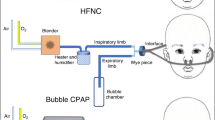Abstract
Around 10–20% of newborns (~13 to 26 million worldwide) require respiratory support after birth. Humidification of inspiratory gases during invasive ventilation has been associated with reduced airway injury. In this chapter, humidification of inspiratory gases during invasive ventilation will be discussed.
Access this chapter
Tax calculation will be finalised at checkout
Purchases are for personal use only
Similar content being viewed by others
References
Pillow JJ, Courtney S. High frequency ventilation. In: Keszler M, Gautham KS, editors. Assisted ventilation of the neonate. 7th ed. Amsterdam: Elsevier; 2021.
Schiffmann H, Singer S, Singer D, Richthofen EV, Rathgeber J, Züchner K. Determination of airway humidification in high-frequency oscillatory ventilation using an artificial neonatal lung model. Intensive Care Med. 1999;25:997–1002. https://doi.org/10.1007/s001340050995.
Chikata Y, Imanaka H, Onishi Y, Ueta M, Nishimura M. Humidification during high-frequency oscillation ventilation is affected by ventilator circuit and ventilatory setting. Pediatr Anesth. 2009;19:779–83. https://doi.org/10.1111/j.1460-9592.2009.03068.x.
Nagaya K, Tsuchida E, Nohara F, Okamoto T, Azuma H. The temperature change in an endotracheal tube during high frequency ventilation using an artificial neonatal lung model with Babylog® 8000 plus. Pediatr Pulmonol. 2015;50:173–8. https://doi.org/10.1002/ppul.22973.
Todd DA, John E, Osborn RA. Tracheal damage following conventional and high-frequency ventilation at low and high humidity. Crit Care Med. 1991;19:1310–6. https://doi.org/10.1097/00003246-199110000-00014.
Todd DA, John E, Osborn R. Recovery of tracheal epithelium following high frequency ventilation at low inspired humidity. Early Hum Dev. 1992;31:53–66. https://doi.org/10.1016/0378-3782(92)90014-8.
Author information
Authors and Affiliations
Editor information
Editors and Affiliations
Rights and permissions
Copyright information
© 2023 The Author(s), under exclusive license to Springer Nature Switzerland AG
About this chapter
Cite this chapter
O’Reilly, M., Schmölzer, G.M. (2023). Humidification in Neonatal-Pediatric Critical Care: Invasive Ventilation. In: Esquinas, A.M. (eds) Humidification in the Intensive Care Unit. Springer, Cham. https://doi.org/10.1007/978-3-031-23953-3_21
Download citation
DOI: https://doi.org/10.1007/978-3-031-23953-3_21
Published:
Publisher Name: Springer, Cham
Print ISBN: 978-3-031-23952-6
Online ISBN: 978-3-031-23953-3
eBook Packages: MedicineMedicine (R0)




